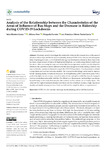Analysis of the Relationship between the Characteristics of the Areas of Influence of Bus Stops and the Decrease in Ridership during COVID-19 Lockdowns

Ver/Abrir
Use este enlace para citar
http://hdl.handle.net/2183/30910Colecciones
- Investigación (ETSECCP) [826]
Metadatos
Mostrar el registro completo del ítemTítulo
Analysis of the Relationship between the Characteristics of the Areas of Influence of Bus Stops and the Decrease in Ridership during COVID-19 LockdownsFecha
2022Cita bibliográfica
Montero-Lamas, Y.; Orro, A.; Novales, M.; Varela-García, F.-A. Analysis of the Relationship between the Characteristics of the Areas of Influence of Bus Stops and the Decrease in Ridership during COVID-19 Lockdowns. Sustainability 2022, 14, 4248. https://doi.org/10.3390/su14074248
Resumen
[Abstract] This study aimed to investigate the relationship between the characteristics of the areas of influence of bus stops and the decrease in ridership during COVID-19 lockdowns and subsequent initial reopening processes. A novel GIS methodology was developed to determine these characteristics from a large amount of data with high spatial detail and accurately assign them to individual bus stops. After processing the data, several multiple linear regression models were developed to determine the variables related to different activities and changes in mobility during lockdown that may explain the variation in demand owing to the COVID-19 pandemic. The characteristics related to population and land use were also studied. The proposed methodology can be used to improve transit planning during exceptional situations, by strengthening public transport in areas with a predictably higher transit demand, instead of uniformly decreasing the availability of public transport services, promoting sustainable mobility. The efficiency of the proposed methodology was shown by performing a case study that analysed the variation in bus demand in A Coruña, Spain. The areas with the highest sustained demand were those with low inhabitant incomes, a high population density, and significant proportions of land use dedicated to hospitals, offices, or supermarkets.
Palabras clave
COVID-19
GIS
Bus stop patronage
Transit planning
Urban mobility
Land use
GIS
Bus stop patronage
Transit planning
Urban mobility
Land use
Versión del editor
Derechos
Atribución 4.0 Internacional






